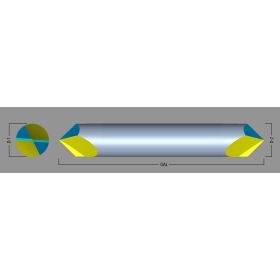A chamfer cutter, or possibly a chamfer mill, is available at any machine shop, assembly floor, or hobbyist’s garage. These cutters are pretty straight forward tools which are useful for chamfering or beveling any section within a wide selection of materials. A lot of to chamfer a part, which range from fluid flow and safety, to part aesthetics.

As a result of diversity of needs, tooling manufacturers offer many different angles and sizes of chamfer cutters, and also a variety of chamfer cutter tip geometries. Harvey Tool, as an example, offers 21 different angles per side, which range from 15° to 80°, flute counts of 2 to 6, and shank diameters starting at 1/8” approximately 1 “.
After obtaining a tool together with the exact angle they’re trying to find, a client might have to go with a certain chamfer cutter tip that will be perfect for their operation. Common types of chamfer cutter tips include pointed, flat end, and end cutting. The subsequent three forms of chamfer cutter tip styles, available from Harvey Tool, each serve a unique purpose.
Three Types of Harvey Tool Chamfer Cutters
Type I: Pointed
This brand of chamfer cutter could be the only Harvey Tool option links into a sharp point. The pointed tip allows the cutter to complete in smaller grooves, slots, and holes, when compared with the other 2 types. This style also provides for easier programming and touch-offs, since the point can easily be located. It’s because tip that this type of the cutter gets the longest length of cut (using the tool earning any finished point), in comparison to the flat end in the other sorts of chamfer cutters. Just a two flute option, this can be the most straightforward type of a chamfer cutter available from Harvey Tool.
Type II: Flat End, Non-End Cutting
Type II chamfer cutters have become like the type I style, but feature an end that’s ground into an appartment, non-cutting tip. This flat “tip” removes the pointed area of the chamfer, which is weakest the main tool. For that reason change in tool geometry, this tool emerges yet another measurement based on how much longer the tool will be whether it located a spot. This measurement is recognized as “distance to theoretical sharp corner,” which assists together with the programming of the tool. The main benefit of the flat end from the cutter now provides for multiple flutes to exist on the tapered profile with the chamfer cutter. With an increase of flutes, this chamfer has improved tool life and handle. The flat, non-end cutting tip flat does limit its utilization in narrow slots, but another advantage is a lower profile angle with better angular velocity on the tip.
Type III: Flat End, End Cutting
Type III chamfer cutters are an improved and much more advanced version of the sort II style. The kind III features a flat end tip with 2 flutes meeting at the center, developing a center cutting-capable form of the sort II cutter. The guts cutting geometry with this cutter makes it possible to cut having its flat tip. This cutting enables the chamfer cutter to lightly reduce the top an element on the bottom of it, instead of leave material behind when cutting a chamfer. There are lots of situations where blending of the tapered wall and floor is needed, and this is where these chamfer cutters shine. The tip diameter is also held to some tight tolerance, which significantly supports programing it.
In conclusion, there may be many suitable cutters for the single job, and there are many questions you have to ask just before picking your ideal tool. Choosing the right angle comes down to ensuring the angle around the chamfer cutter matches the angle for the part. You need to use caution of the way the angles are classified as out, as well. Is the angle an “included angle” or “angle per side?” Will be the angle called off from the vertical or horizontal? Next, the larger the shank diameter, the stronger the chamfer along with the longer the size of cut, these days, interference with walls or fixtures should be considered. Flute count comes down to material and handle. Softer materials usually want less flutes for much better chip evacuation, while more flutes will help with finish. After addressing each of these considerations, the proper type of chamfer to your job must be abundantly clear.
To learn more about chamfer cutter go our new website
